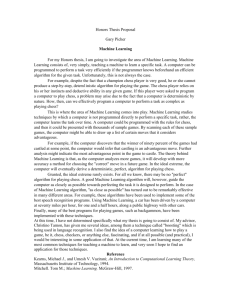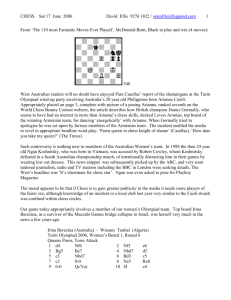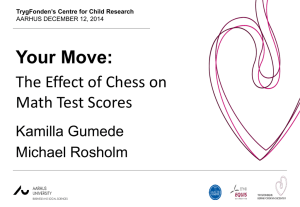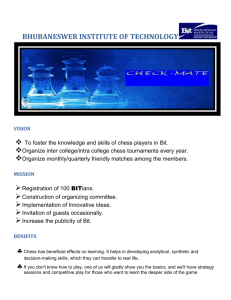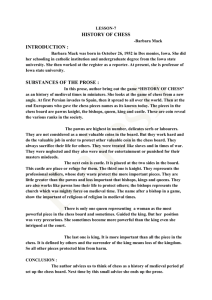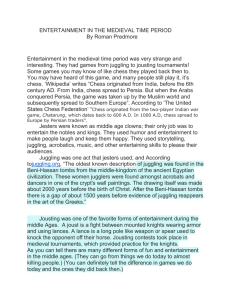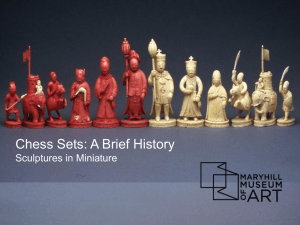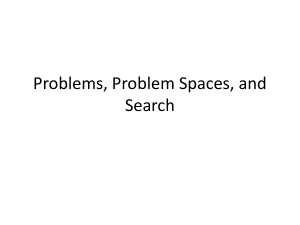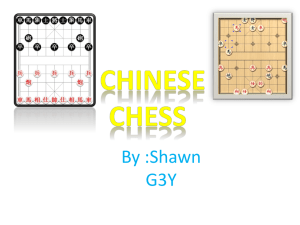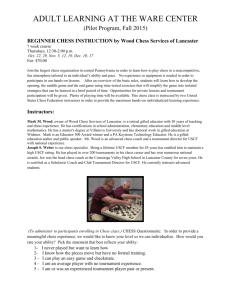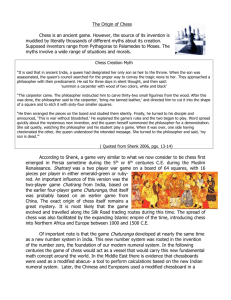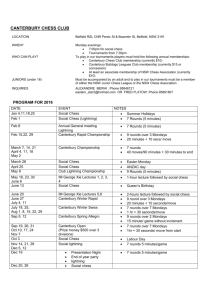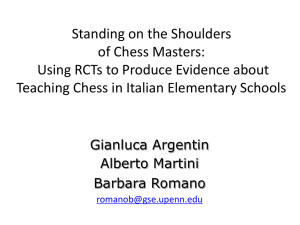Introduction to AI
advertisement
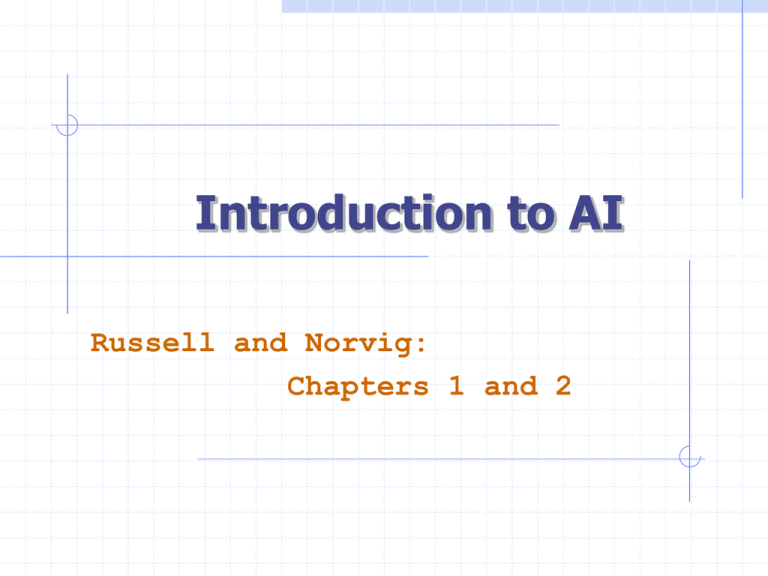
Introduction to AI Russell and Norvig: Chapters 1 and 2 Found on the Web … AI is the reproduction of the methods of Intelligent behavior human reasoning or intuition Computer Using computational models to simulate intelligent (human) behavior and processes AI is the study of mental faculties through the Humans use computational methods Introduction to AI 2 I personally think that AI started as a rebellion against some form of establishment telling us “Computers cannot perform certain tasks requiring intelligence” For example, for many years AI researchers have regarded computational complexity theory as irrelevant to their field. They eventually had to reckon with it, but in the meantime computational complexity had also changed a lot. Introduction to AI 3 What is AI? Discipline that systematizes and automates intellectual tasks to create machines that: Act like humans Act rationally Think like humans Think rationally Introduction to AI 4 Act Like Humans AI is the art of creating machines that perform functions that require intelligence when performed by humans Methodology: Take an intellectual task at which people are better and make a computer do it •Prove a theorem •Play chess Turing test •Plan a surgical operation •Diagnose a disease •Navigate in a building Introduction to AI 5 Chess Name: Garry Kasparov Title: World Chess Champion Crime: Valued greed over common sense Humans are still better at making up excuses. © Jonathan Schaeffer Introduction to AI 6 Perspective on Chess: Pro “Saying Deep Blue doesn’t really think about chess is like saying an airplane doesn't really fly because it doesn't flap its wings” Drew McDermott © Jonathan Schaeffer Introduction to AI 7 나비가 나는 이유? 나비는 유체역학적으로 날 수가 없다. 그러나 나비는 그 사실을 모르기 때문에 날 수 있다. 나비는 유체역학적으로 날기에 부적합하다. 제비는 적합하다. 그러나 나비는 제비 못지않게 잘 번성하고 있다. 나비처럼 나는 것도 이유가 있다. 어떤 나비는 미국에서 호주까지 날아가기도 한다. 흉내보다는 같은 기능을 하면 충분!! 두 발로 걷는 로봇 ? 지네 같은 로봇 ? Introduction to AI 8 Perspective on Chess: Con “Chess is the Drosophila of artificial intelligence. However, computer chess has developed much as genetics might have if the geneticists had concentrated their efforts starting in 1910 on breeding racing Drosophila. We would have some science, but mainly we would have very fast fruit flies.” John McCarthy © Jonathan Schaeffer Introduction to AI 9 Think Like Humans How the computer performs functions does matter Comparison of the traces of the reasoning steps Cognitive science testable theories of the workings of the human mind But, do we want to duplicate human imperfections? Introduction to AI 10 Think/Act Rationally Always make the best decision given what is available (knowledge, time, resources) •Connection to economics, A performance measure operational is required research, and control theory 객관적인가? 청소로봇, 보상(reward) 디자이너의 •But ignores role평가기준? of consciousness, emotions, 자원의 제한이 있을 때? fear of dying on intelligence Perfect knowledge, unlimited resources logical reasoning Imperfect knowledge, limited resources (limited) rationality Introduction to AI 11 Bits of History 1956: The name “Artificial Intelligence” was coined. (Would “computational rationality” have been better?) Early period (50’s to late 60’s): Basic principles and generality General problem solving Theorem proving Games Formal calculus Introduction to AI 12 Bits of History 1969-1971: Shakey the robot (Fikes, Hart, Nilsson) Logic-based planning (STRIPS) Motion planning (visibility graph) Inductive learning (PLANEX) Computer vision Introduction to AI 13 Bits of History Knowledge-is-Power period (late 60’s to mid 80’s): Focus on narrow tasks require expertise Encoding of expertise in rule form: If: the car has off-highway tires and 4-wheel drive and high ground clearance Then: the car can traverse difficult terrain (0.8) Knowledge engineering 5th generation computer project CYC system (Lenat) Introduction to AI 14 Bits of History AI becomes an industry (80’s – present): Expert systems: Digital Equipment, Teknowledge, Intellicorp, Du Pont, oil industry, … Lisp machines: LMI, Symbolics, … Constraint programming: ILOG Robotics: Machine Intelligence Corporation, Adept, GMF (Fanuc), ABB, … Speech understanding Introduction to AI 15 Bits of History The return of neural networks, genetic algorithms, and artificial life (80’s – 90’s) Increased connection with economics, operational research, and control theory (90’s – present) AI becomes less philosophical, more technical and mathematically oriented Introduction to AI 16 Predictions and Reality … (1/3) In the 60’s, a famous AI professor from MIT said: “At the end of the summer, we will have developed an electronic eye” As of 2002, there is still no general computer vision system capable of understanding complex dynamic scenes But computer systems routinely perform road traffic monitoring, facial recognition, some medical image analysis, part inspection, etc… Introduction to AI 17 Predictions and Reality … (2/3) In 1958, Herbert Simon (CMU) predicted that within 10 years a computer would be Chess champion This prediction became true in 1998 Today, computers have won over world champions in several games, including Checkers, Othello, and Chess, but still do not do well in Go Introduction to AI 18 Predictions and Reality … (3/3) In the 70’s, many believed that computer-controlled robots would soon be everywhere from manufacturing plants to home Today, some industries (automobile, electronics) are highly robotized, but home robots are still a thing of the future But robots have rolled on Mars, others are performing brain and heart surgery, and humanoid robots are operational and available for rent (see: http://world.honda.com/news/2001/c011112.html) Introduction to AI 19 Mistakes … Often, the potential of a new field is over-estimated in its early age, but under-estimated over the longer term AI proponents have over-estimated the need for smart software, and underestimated the feasibility and potential of large software systems based on massive coding effort Introduction to AI 20 생물학적으로 본 인간 인류의 진화 뇌의 크기 언어의 사용 도구의 사용 직립보행 사회생활 예측에 의한 행동 ? Introduction to AI 21 본능인가 학습인가? 각인 언어능력 모국어 Introduction to AI 22 인간과 다른 유인원 Introduction to AI 23 Sahelanthropus tchadensis 뇌의 진화과정 원인류 네안데르탈 인 Homo sapiens 1300-1700 cc 600만 500만 400만 300만 유럽인 100만 200만 아프리카인 오스트랄로 피테쿠스 뇌용적 : 400-500 cc Homo habilus (handy man) 600-800 cc Homo erectus 동아시아인 800-1200 cc 호주 원주민 Introduction to AI 24 뇌의 용량 Introduction to AI 25 인류의 진화 Introduction to AI 26 Human Brain Chimpanzee Brain Introduction to AI 27 보복전쟁 원인은 진화덜된 두뇌탓 미국 폴 로스코 교수 주장 미국 과학진흥협회 (AAAS) annual meeting “핵 기술을 보유한 인간의 두뇌가 여전히 석기 시대 수준에 머물러 있다” “자신뿐 아니라 자기 종족까지 죽이는 ‘복수’ 행위는 정상적인 진화의 산물이 아니다” Introduction to AI 28 일란성 쌍둥이 연구 건선 강한 유전자 영향 우울병 정신분열병 IQ 신경증 당뇨병 천식 심장병 암 다발성 경화증 Introduction to AI 약한 유전자 영향 29 언어의 진화 Introduction to AI 30 'Speech Gene' Tied to Modern Humans FOXP2 gene - first identified by Monaco’s group at Oxford University (Science 2001) - 715 amino acids, two amino acid mutation in human lineage since 6 million years ago – fixed at 120,000 – 200,000 years ago (Svante Paabo, Nature 2002) Evolutionary leap. One of these primates is able to talk about what he's seeing; the other isn't. Introduction to AI 31 언어를 관할하는 FOXP2 유전자의 돌연변이 Introduction to AI 32 유전자의 영향 IQ (어머니와 아들) 모성애 (아버지와 딸 (NAST)) 도파민 D4 수용체(11번 염색체) • 3번 exon(long) : 창조성, 탐구성, 스릴 추구 • 3번 exon(short) : 완고, 융통성 결여 • D4 장애 : 정신분열병 Introduction to AI 33 아인슈타인의 뇌 Introduction to AI 34 폭력의 생물학 Richard J. Davidson et al., Science 2000 (폭력과 전전두엽 장애 – 세로토닌 신경계 장애) 연쇄살인자 – 세로토닌 장애 – 책임문제 Introduction to AI 정신분열병 – 도파민 장애 – 살인 - 면죄부 35 생체 전자 공학 기록전극 부분의 확대도 전극의 전체 레이아웃 배양을 시작한 직후의 신경세포종의 모습 배양 후 2일이 경과한 신경세포종의 모습 Introduction to AI 36 생체전자공학 뇌에 기계 또는 전자적 연결 눈 수술 귀 수술 Introduction to AI 37 뇌의 특정 유전자 과도 발현하는 형질 전환 마우스 제조 (smart mice) T. V. P. BLISS et al., Nature,1999 transgenic mice overexpressing the NR2B subunit of the NMDA receptor Introduction to AI 38 최초의 유전자 치료술 (중증 복합 면역결핍증, SCID) Introduction to AI 39 Mistakes … Often, the potential of a new field is over-estimated in its early age, but under-estimated over the longer term What about Bio-informatics? 줄기세포의 치료효과 쥐의 실험에 의하면 척추장애를 완벽히 치료 그러나 저항력이 없는 쥐에서는 바로 암으로 전이, 있을 때에도 3개월 뒤면 암으로 전이 ? 탄소 큐브 (나노기술) 완벽한 새로운 물질 인류는 경험하지 못했으며, 가장 무서운 발암물질? 핵, 유전자변형??? Introduction to AI 40 Intelligent Agent 인간의 능력을 대신할 수 있는 부분적: 걷는? 말하는? 판단하는? 인간과 같은? 지능적 능력을 가진 인간과 다른 형태의? 말하는 개? 말하는 앵무새? 덧셈을 하는 개? 비교: SOAP, Service-oriented approach, XML, Context, … Introduction to AI 41 Notion of an Agent sensors ? environment agent actuators laser range finder sonars Introduction to AI touch sensors 42 Notion of an Agent sensors ? environment agent actuators Introduction to AI 43 Notion of an Agent sensors ? environment agent actuators •Locality of sensors/actuators •Imperfect modeling •Time/resource constraints •Sequential interaction •Multi-agent worlds Introduction to AI 44 단순화한 인공지능 문제 에이전트의 조건 성공을 평가한 판단기준 환경 또는 응용영역에 대한 사전지식 Agent가 행할 수 있는 행위 현재까지 한 행위와 결과에 대한 인식 문제의 어려움 Fully observable vs. Partially observable Deterministic vs. Stochastic Episodic vs. Sequential Static vs. Dynamic Discrete vs. Continuous Single agent vs. Multiagent Introduction to AI 45 Example: Tracking a Target • The robot must keep the target in view • The target’s trajectory is not known in advance • The robot may not know all the obstacles in advance • Fast decision is required robot Introduction to AI target 46

